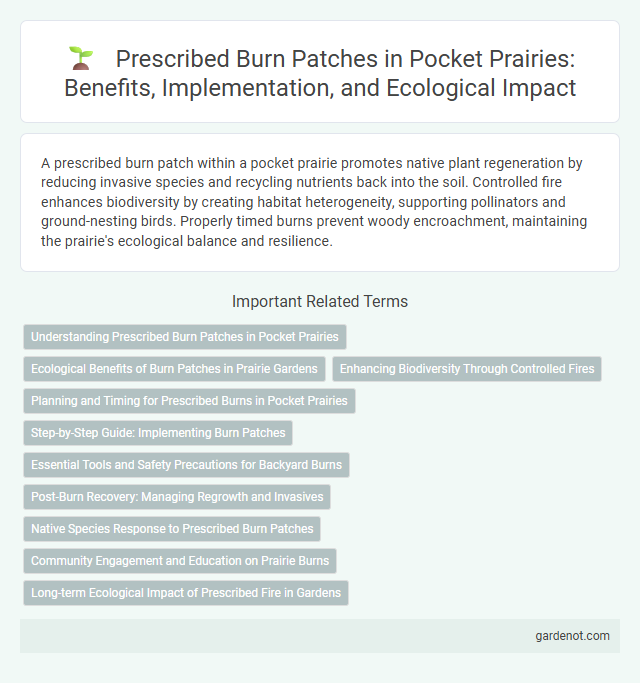A prescribed burn patch within a pocket prairie promotes native plant regeneration by reducing invasive species and recycling nutrients back into the soil. Controlled fire enhances biodiversity by creating habitat heterogeneity, supporting pollinators and ground-nesting birds. Properly timed burns prevent woody encroachment, maintaining the prairie's ecological balance and resilience.
Understanding Prescribed Burn Patches in Pocket Prairies
Prescribed burn patches in pocket prairies are carefully managed areas where controlled fires are used to mimic natural fire cycles, promoting native plant growth and enhancing biodiversity. These burns reduce invasive species and accumulated dead biomass, improving soil health and habitat quality. Understanding the timing, frequency, and scale of prescribed burns is crucial for maintaining ecological balance and supporting native wildlife populations.
Ecological Benefits of Burn Patches in Prairie Gardens
Prescribed burn patches in pocket prairies enhance biodiversity by stimulating native plant growth and controlling invasive species. Fire resets nutrient cycles, enriching soil fertility and promoting vigorous plant regeneration. These burns create habitat diversity that supports pollinators, small mammals, and ground-nesting birds essential for prairie ecosystem health.
Enhancing Biodiversity Through Controlled Fires
Prescribed burn patches in pocket prairies play a crucial role in enhancing biodiversity by mimicking natural fire cycles that promote native plant growth and control invasive species. These controlled fires increase habitat heterogeneity, supporting diverse wildlife populations and improving soil health through nutrient recycling. Fire-adapted plants such as big bluestem and Indian grass thrive after burns, fostering a balanced and resilient prairie ecosystem.
Planning and Timing for Prescribed Burns in Pocket Prairies
Effective planning and timing for prescribed burns in pocket prairies enhance native biodiversity and control invasive species. Optimal burn windows typically occur in late winter to early spring when soil moisture is adequate, and target plants are dormant, minimizing damage to desirable vegetation. Detailed burn prescriptions consider weather conditions, fuel loads, and local wildlife activity to ensure safe, ecologically beneficial outcomes.
Step-by-Step Guide: Implementing Burn Patches
Implementing burn patches in a pocket prairie requires careful planning, starting with identifying appropriate areas that promote native plant growth while reducing invasive species. Prepare the site by removing excessive debris and creating firebreaks to control the burn, followed by selecting ideal weather conditions to ensure safety and effectiveness. Execute the prescribed burn under controlled settings, monitoring fire behavior closely to achieve desired ecological outcomes and support prairie restoration.
Essential Tools and Safety Precautions for Backyard Burns
Essential tools for a prescribed burn patch in a pocket prairie include a water source, fire rake, and protective gear such as gloves and goggles to ensure effective fire control. Safety precautions involve checking local regulations, monitoring weather conditions closely for suitable burn days, and establishing clear firebreaks to prevent wildfire spread. Always notify neighbors and have a communication plan in place to maintain control and minimize risks during backyard burns.
Post-Burn Recovery: Managing Regrowth and Invasives
Post-burn recovery in a prescribed burn patch involves careful monitoring of native plant regrowth and proactive management of invasive species to maintain ecosystem balance. Techniques such as spot treatment with herbicides and manual removal help suppress invasive plants while encouraging the proliferation of native prairie species. Consistent assessment of vegetation composition and soil health guides adaptive management practices, ensuring the long-term resilience of the pocket prairie habitat.
Native Species Response to Prescribed Burn Patches
Prescribed burn patches in pocket prairies significantly enhance native species diversity by promoting the growth of fire-adapted plants such as big bluestem, Indian grass, and black-eyed Susan. These burns reduce invasive species and increase nutrient availability, creating favorable conditions for native flora regeneration. Native pollinators and ground-nesting birds also benefit from the open habitat structure resulting from prescribed fire management.
Community Engagement and Education on Prairie Burns
Prescribed burn patches in pocket prairies serve as vital tools for community engagement and education, fostering local awareness about prairie ecosystem management. Organizing hands-on prairie burn demonstrations and workshops helps residents understand fire's ecological role in promoting biodiversity and controlling invasive species. Collaborative efforts with schools and environmental groups amplify the learning experience, empowering communities to actively participate in sustainable prairie conservation practices.
Long-term Ecological Impact of Prescribed Fire in Gardens
Prescribed burn patches in pocket prairies enhance soil nutrient cycling and promote native plant diversity by reducing invasive species over time. These controlled fires stimulate seed germination and improve habitat structure for pollinators and beneficial insects, supporting ecosystem resilience. Long-term ecological benefits include increased organic matter decomposition and sustained plant community health, fostering a balanced garden environment.
Prescribed burn patch Infographic

 gardenot.com
gardenot.com